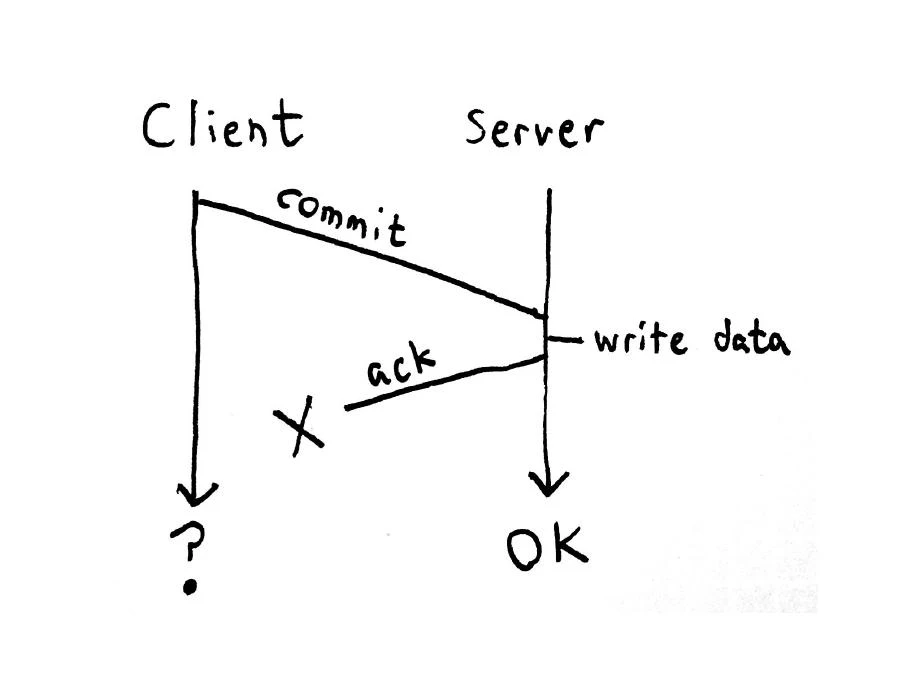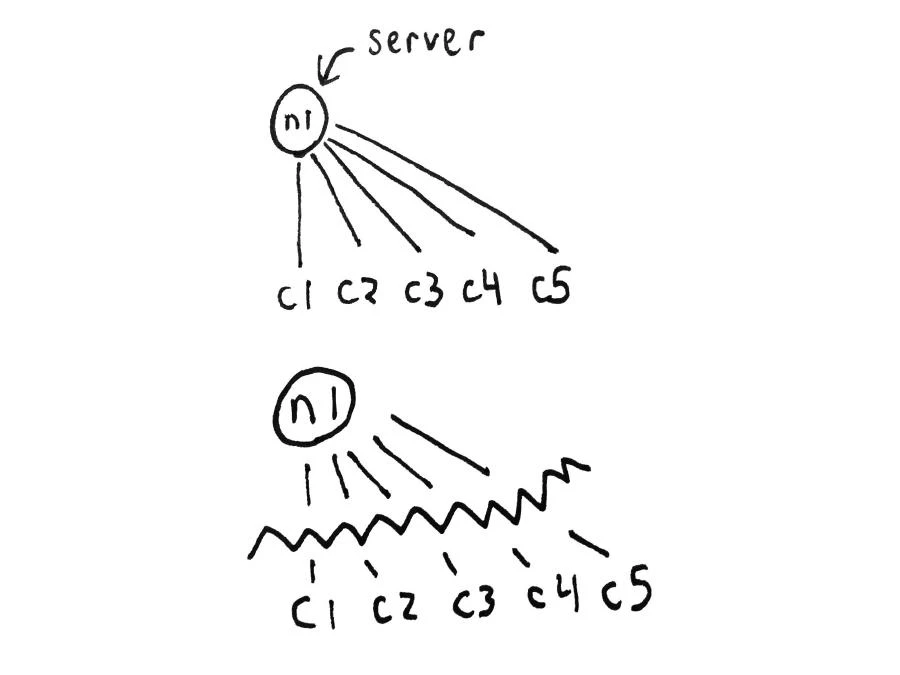Previously on Jepsen, we introduced the problem of network partitions. Here, we demonstrate that a few transactions which “fail” during the start of a partition may have actually succeeded.
Postgresql is a terrific open-source relational database. It offers a variety of consistency guarantees, from read uncommitted to serializable. Because Postgres only accepts writes on a single primary node, we think of it as a CP system in the sense of the CAP theorem. If a partition occurs and you can’t talk to the server, the system is unavailable. Because transactions are ACID, we’re always consistent.
Right?
Well… almost. Even though the Postgres server is always consistent, the distributed system composed of the server and client together may not be consistent. It’s possible for the client and server to disagree about whether or not a transaction took place.


Postgres’ commit protocol, like most relational databases, is a special case of two-phase commit, or 2PC. In the first phase, the client votes to commit (or abort) the current transaction, and sends that message to the server. The server checks to see whether its consistency constraints allow the transaction to proceed, and if so, it votes to commit. It writes the transaction to storage and informs the client that the commit has taken place (or failed, as the case may be.) Now both the client and server agree on the outcome of the transaction.
What happens if the message acknowledging the commit is dropped before the client receives it? Then the client doesn’t know whether the commit succeeded or not! The 2PC protocol says that we must wait for the acknowledgement message to arrive in order to decide the outcome. If it doesn’t arrive, 2PC deadlocks. It’s not a partition-tolerant protocol. Waiting forever isn’t realistic for real systems, so at some point the client will time out and declare an error occurred. The commit protocol is now in an indeterminate state.
To demonstrate this, we’ll need an install of Postgres to work with.
salticid postgres.setup
This installs Postgres from apt, uploads some config files from
jepsen/salticid/postgres, and creates a database for Jepsen. Then we’ll run a simple application which writes a single row for each number, inside a transaction.
cd salticid
lein run pg -n 100
If all goes well, you’ll see something like
...
85 :ok
91 :ok
90 :ok
95 :ok
96 :ok
Hit enter when ready to collect results.
Writes completed in 0.317 seconds
100 total
100 acknowledged
100 survivors
All 100 writes succeeded. :-D

Each line shows the number being written, followed by whether it was OK or not. In this example, all five nodes talk to a single postgres server on n1. Out of 100 writes, the clients reported that all 100 succeeded–and at the end of the test, all 100 numbers were present in the result set.
Now let’s cause a partition. Since this failure mode only arises when the connection drops after the server decides to acknowledge, but before the client receives it, there’s only a short window in which to begin the partition. We can widen that window by slowing down the network:
salticid jepsen.slow
Now, we start the test:
lein run pg
And while it’s running, cut off all postgres traffic to and from n1:
salticid jepsen.drop_pg
If we’re lucky, we’ll manage to catch one of those acknowledgement packets in flight, and the client will log an error like:
217 An I/O error occurred while sending to the backend.
Failure to execute query with SQL:
INSERT INTO "set_app" ("element") VALUES (?) :: [219]
PSQLException:
Message: An I/O error occured while sending to the backend.
SQLState: 08006
Error Code: 0
218 An I/O error occured while sending to the backend.
After that, new transactions will just time out; the client will correctly log these as failures:
220 Connection attempt timed out.
222 Connection attempt timed out.
We can resolve the partition with salticid jepsen.heal, and wait for the test to complete.
1000 total
950 acknowledged
952 survivors
2 unacknowledged writes found! ヽ(´ー`)ノ
(215 218)
0.95 ack rate
0.0 loss rate
0.002105263 unacknowledged but successful rate

So out of 1000 attempted writes, 950 were successfully acknowledged, and all 950 of those writes were present in the result set. However, two writes (215 and 218) succeeded, even though they threw an exception claiming that a failure occurred! Note that this exception doesn’t guarantee that the write succeeded or failed: 217 also threw an I/O error while sending, but because the connection dropped before the client’s commit message arrived at the server, the transaction never took place.
There is no way to distinguish these cases from the client. A network partition–and indeed, most network errors–doesn’t mean a failure. It means the absence of information. Without a partition-tolerant commit protocol, like extended three-phase commit, we cannot assert the state of the system for these writes.
2PC strategies
Two-phase commit protocols aren’t just for relational databases. They crop up in all sorts of consensus problems. Mongodb’s documents essentially comprise an asynchronous network, and many users implement 2PC on top of their Mongo objects to obtain multi-key transactions.
If you’re working with two-phase commit, there are a few things you can do. One is to accept false negatives. In most relational databases, the probability of this failure occurring is low–and it can only affect writes which were in-flight at the time the partition began. It may be perfectly acceptable to return failures to clients even if there’s a small chance the transaction succeeded.
Alternatively, you can use consistency guarantees or other data structures to allow for idempotent operations. When you encounter a network error, just retry them blindly. A highly available queue with at-least-once delivery is a great place to put repeatable writes which need to be retried later.
Finally, within some databases you can obtain strong consistency by taking note of the current transaction ID, and writing that ID to the database during the transaction. When the partition is resolved, the client can either retry or cancel the transaction at a later time, by checking whether or not that transaction ID was written. Again, this relies on having some sort of storage suitable for the timescales of the partition: perhaps a local log on disk, or an at-least-once queue.
In the next post, we look at a very different kind of consistency model: Redis Sentinel.
bah… can’t see what you’ve put in your “heal” and few other scripts, only browsed rapidly through that unreadable clojure thing (sorry, never liked lisp-like languages). So I quite don’t understand what’s behind your “survivors” messages.
Additionnally, with PG and other R-DMBS, 2PC is not used for single-branch transactions, so I have serious doubts against the whole article. And the behaviour you describe seems normal and expected (I have already seen it with Oracle+JDBC).
FWIW with real 2PC you would have ended with stale transactions ready to commit, which would require manual intervention to definitely commit or rollback.